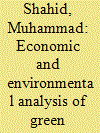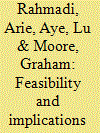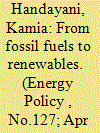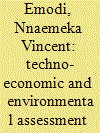|
|
|
Sort Order |
|
|
|
Items / Page
|
|
|
|
|
|
|
| Srl | Item |
| 1 |
ID:
186431


|
|
|
|
|
| Summary/Abstract |
The transport sector is going through a transition from a traditional to a sustainable system. Advanced countries have evaluated the costs and benefits of such transition, however, developing countries like Pakistan have rarely looked into evaluating such transition rigorously. This paper uses the transport sector of Pakistan as a case study and provides an economic evaluation of different scenarios for sustainable transportation in the region. The study has used the Long-range Energy Alternative Planning (LEAP) framework to evaluate the environmental and social costs of three scenarios, Business as Usual Scenario (BAUS), Efficient Combustion Scenario (ECS), and Hybrid Vehicle Scenario (HVS). It concluded that by 2040, the HVS and ECS will reduce carbon dioxide emissions by 303.7 and 213.3 million metric tons respectively compared to BAUS. These savings in terms of social cost will be US$ 10.1 billion in HVS and US$ 7.2 billion in ECS as compared to BAUS. By the year 2040, oil demand in the transportation system will also be possible to contain at the 2026 level. This research is anticipated to help discover the best policy decisions for increasing the share of green fuels in the transport sector of Pakistan.
|
|
|
|
|
|
|
|
|
|
|
|
|
|
|
|
| 2 |
ID:
125485


|
|
|
|
|
| Publication |
2013.
|
| Summary/Abstract |
This paper identifies conventional liquid fossil fuels that can be replaced or blended with biofuel and quantifies the biofuels required to meet the Indonesian biofuel target of at least 5% of the total primary energy mix in 2025. The analysis was conducted using the Long range Energy Alternatives Planning (LEAP) system with an energy elasticity of 1 and maximum allowable biofuel blending ratios according to the current best practices. The results show that the target could be achieved with the maximum blending alternative based on constant energy demand growth of 6%. The target requires a total contribution from biofuel of about 8-27 GL in 2025 depending on blending ratios. In energy terms, these are equivalent to 232-782 PJ or about 40-135 million barrels crude oil, which constitute roughly around 3.3-11.0% of the estimated liquid fossil fuel oil annual consumption in that year. The results imply that it may have detrimental environmental impact, as it requires 5.2 million ha of palm oil and sugar cane plantations. On the positive side, achieving the target offers potential new employment opportunities of about 3.4 million jobs, particularly in the agricultural sector relevant to liquid biofuel production.
|
|
|
|
|
|
|
|
|
|
|
|
|
|
|
|
| 3 |
ID:
166341


|
|
|
|
|
| Summary/Abstract |
This study analyses a diffusion of renewable energy in an electricity system accounting for technological learning. We explore long-term scenarios for capacity expansion of the Java-Bali electricity system in Indonesia, considering the country’s renewable energy targets. We apply the Long-range Energy Alternative Planning (LEAP) model with an integration of technological learning. Our results reveal that, at the medium and high pace of technological learning, the total costs of electricity production to achieve the long-term renewable energy target are 4–10% lower than the scenario without considering technological learning. With respect to technology, solar PV and wind become competitive with other types of renewables and nuclear. Moreover, the fulfilment of the renewable energy targets decreases CO2 emissions by 25% compared to the reference scenario. Implications of our results indicate that energy policies should focus on the early deployment of renewables, upgrading the grid capacity to accommodate variable renewable energy, and enabling faster local learning.
|
|
|
|
|
|
|
|
|
|
|
|
|
|
|
|
| 4 |
ID:
166332


|
|
|
|
|
| Summary/Abstract |
This study aims to provide roadmaps for the sustainable development of South Korea's energy system. To this end, this study developed transition scenarios toward renewable energy for both supply and demand. We use “Long-range Energy Alternatives Planning system (LEAP)” Model and a backcasting approach to illustrate pathways to achieve the goals set forth in each of the scenarios. The four scenarios developed are Business-As-Usual (BAU), Moderate Transition Scenario (MTS), Advanced Transition Scenario (ATS), and Visionary Transition Scenario (VTS). The scenarios are defined according to the differences in the level of final energy consumption and renewable energy share by 2050. Analysis shows an increase in the percentage of renewable energy and a decrease in energy demand lead to improved energy security, more jobs in the electricity generation sector, and a decrease in greenhouse gas emissions. The pathways represented by these scenarios can be regarded as strategic targets for the sustainable development of South Korea's energy system. A set of comprehensive and long-term policies will be needed to attain the goals set forth in the scenarios.
|
|
|
|
|
|
|
|
|
|
|
|
|
|
|
|
| 5 |
ID:
110351


|
|
|
|
|
| Publication |
2011.
|
| Summary/Abstract |
Facing multiple pressures, including its commitment to energy efficiency improvement, the current worldwide recession, and global warming concerns, China is making great efforts to maintain its continuous economic growth and reduce pollutant emissions. Many policies to encourage investing in energy efficiency and renewable energy have been issued. This article provides insights into the latest development of energy production, energy consumption and energy strategic planning and policies in China, and also describes the analysis, carried out by the authors as part of the Asian Energy Security project using the Long-range Energy Alternatives Planning (LEAP) modeling tool, of the impacts of implementing new and expected energy and environmental policies.
|
|
|
|
|
|
|
|
|
|
|
|
|
|
|
|
| 6 |
ID:
166395


|
|
|
|
|
| Summary/Abstract |
This paper examines the impact of climate variability and change (CV&C), and energy policies on the future energy system in Australia. Scenarios were developed to represent CV&C impacts and policy options, which were analysed with the Long-range Energy Alternative and Planning system for the period 2010–2050. The results indicate that although energy demand is likely to increase threefold in the business-as-usual scenario, CV&C further increases demand to 150 petajoule. A combined policy option involving modal shift and penetration of electric and hydrogen fuel cell vehicles results in a 49–53% decrease in transport fuel demand and emissions. The economic analysis reveals a substantial decline in sales revenue and increase in generation costs due to CV&C impacts. Higher renewable energy integration results in lower wholesale electricity prices across independent electricity markets. Cumulative cost-benefit analysis indicates that economic benefits increase to US$4.9 trillion in an advanced renewable energy scenario. Emissions and energy consumed increased under climatic conditions, but decreased after policy intervention. Ignoring the influence of CV&C may result in underestimation of future energy demand and installed capacity in Australia. Therefore, energy and climate policies should consider long-term economic benefits over short-term system costs.
|
|
|
|
|
|
|
|
|
|
|
|
|
|
|
|
|
|
|
|
|